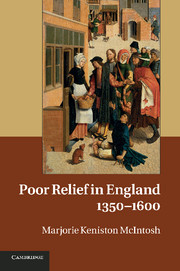Book contents
- Frontmatter
- Contents
- Acknowledgements
- Notes on conventions and online resources
- Abbreviations
- 1 Introduction
- Part I Late medieval and early Tudor patterns
- Part II Profound change during the early Reformation period
- Part III Intensified problems and altered approaches in the later sixteenth century
- 6 The burgeoning of begging, collection, and fraud
- 7 The changing nature of almshouses and hospitals
- 8 Support for the parish poor
- Part IV Responding to the problems
- Appendices included in the printed volume
7 - The changing nature of almshouses and hospitals
Published online by Cambridge University Press: 05 January 2012
- Frontmatter
- Contents
- Acknowledgements
- Notes on conventions and online resources
- Abbreviations
- 1 Introduction
- Part I Late medieval and early Tudor patterns
- Part II Profound change during the early Reformation period
- Part III Intensified problems and altered approaches in the later sixteenth century
- 6 The burgeoning of begging, collection, and fraud
- 7 The changing nature of almshouses and hospitals
- 8 Support for the parish poor
- Part IV Responding to the problems
- Appendices included in the printed volume
Summary
The almshouses and hospitals that operated during the second half of the sixteenth century, especially newly founded or re-founded ones, differed from their predecessors in many respects. The number of houses had dropped sharply as a result of the closing of religious institutions and royal confiscation of property between 1536 and 1553. Because institutions founded after 1540 were also generally smaller than their predecessors, the total number of people supported in the 1560s and even in the 1590s was considerably lower than in the 1520s. England’s population was rising rapidly, so residential institutions provided accommodation for a much smaller fraction of the population in the late sixteenth century than they had in the fifteenth and early sixteenth centuries. Institutions established after 1540 (the great majority of which were almshouses) were heavily weighted towards elderly poor people, often women, and privacy for residents increased.
Because almshouses could no longer offer prayers for the dead, the reasons for establishing and maintaining such institutions had to be reassessed. Many houses still required prayer and thanksgiving for the generosity of founders and benefactors, but their social role as providers of care within the community became more important and expectations for good behavior increased. Dislike of begging and a belief in labor led many founders of new houses to provide a cash allowance to their residents and sometimes to prohibit idleness. A desire to make the beneficence of the donor visible within the community brought expanded use of distinctive liveries for inmates to wear when they were away from the institution, which in turn reinforced a collective identity.
- Type
- Chapter
- Information
- Poor Relief in England, 1350–1600 , pp. 186 - 224Publisher: Cambridge University PressPrint publication year: 2011



